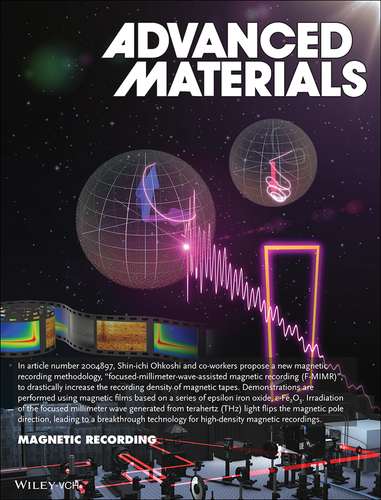R&D: Magnetic Recording Magnetic‐Pole Flip by Millimeter Wave
Magnetic recording methodology, focused‐millimeter‐wave‐assisted magnetic recording, to increase recording density of magnetic tapes
This is a Press Release edited by StorageNewsletter.com on January 25, 2021 at 2:21 pmAdvanced Materials has published an article written by Shin‐ichi Ohkoshi, Marie Yoshikiyo, Kenta Imoto, Kosuke Nakagawa, Asuka Namai, Department of Chemistry, School of Science, The University of Tokyo, 7‐3‐1 Hongo, Bunkyo‐ku, Tokyo, 113‐0033 Japan, Hiroko Tokoro Department of Chemistry, School of Science, The University of Tokyo, 7‐3‐1 Hongo, Bunkyo‐ku, Tokyo, 113‐0033 Japan, and Department of Materials Science, Faculty of Pure and Applied Sciences, University of Tsukuba, 1‐1‐1 Tennodai, Tsukuba, Ibaraki, 305–8577 Japan, Yuji Yahagi, Department of Materials Science, Faculty of Pure and Applied Sciences, University of Tsukuba, 1‐1‐1 Tennodai, Tsukuba, Ibaraki, 305–8577 Japan, Kyohei Takeuchi, Fangda Jia, Seiji Miyashita, Department of Physics, School of Science, The University of Tokyo, 7‐3‐1 Hongo, Bunkyo‐ku, Tokyo, 113‐0033 Japan, Makoto Nakajima, Hongsong Qiu, Kosaku Kato, Institute of Laser Engineering, Osaka University, 2‐6 Yamadaoka, Suita, Osaka, 565–0871 Japan, Takehiro Yamaoka, Analysis Systems Solution Development Dept., Metrology and Analysis Systems Product Div., Hitachi High‐Tech Corporation, 3‐2‐1 Sakado, Takatsu‐ku, Kawasaki, Kanagawa, 213‐0012 Japan, Masashi Shirata, Kenji Naoi,Koichi Yagishita,and Hiroaki Doshita, Recording Media Research & Development Laboratories, FujiFilm Corporation, 12‐1, Ohgi‐cho 2‐Chome, Odawara‐shi, Kanagawa, 250‐0001 Japan.
Abstract: “In the era of Big Data and the Internet of Things, data archiving is a key technology. From this viewpoint, magnetic recordings are drawing attention because they guarantee long‐term data storage. To archive an enormous amount of data, further increase of the recording density is necessary. Herein a new magnetic recording methodology, ‘focused‐millimeter‐wave‐assisted magnetic recording (F‐MIMR),’ is proposed. To test this methodology, magnetic films based on epsilon iron oxide nanoparticles are prepared and a focused‐millimeter‐wave generator is constructed using terahertz (THz) light. Irradiating the focused millimeter wave to epsilon iron oxide instantly switches its magnetic pole direction. The spin dynamics of F‐MIMR are also calculated using the stochastic Landau–Lifshitz–Gilbert model considering all of the spins in an epsilon iron oxide nanoparticle. In F‐MIMR, the heat‐up effect of the recording media is expected to be suppressed. Thus, F‐MIMR can be applied to high‐density magnetic recordings.“
In article number 2004897, Shin‐ichi Ohkoshi and co‐workers propose a new magnetic recording methodology, ‘focused‐millimeter‐wave‐assisted magnetic recording (F‐MIMR)’, to drastically increase the recording density of magnetic tapes. Demonstrations are performed using magnetic films based on a series of epsilon iron oxide, ε‐Fe2O3. Irradiation of the focused millimeter wave generated from terahertz (THz) light flips the magnetic pole direction, leading to a breakthrough technology for high‐density magnetic recordings.















 Subscribe to our free daily newsletter
Subscribe to our free daily newsletter


